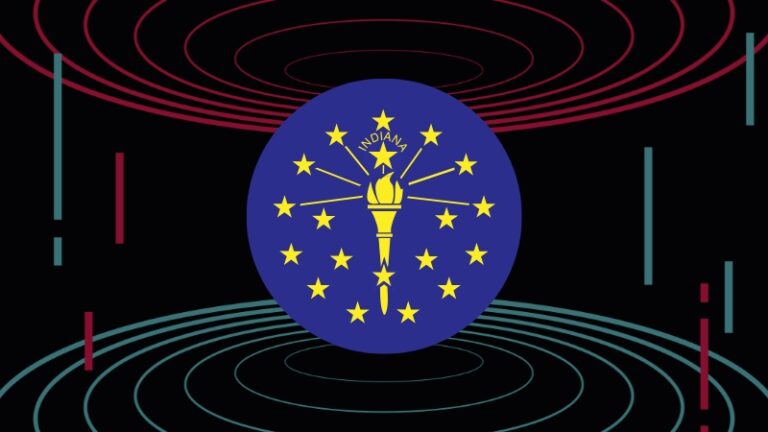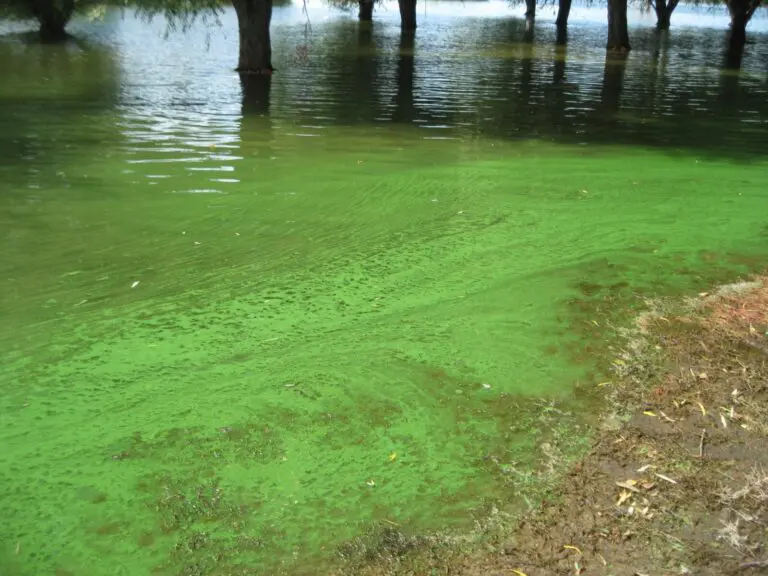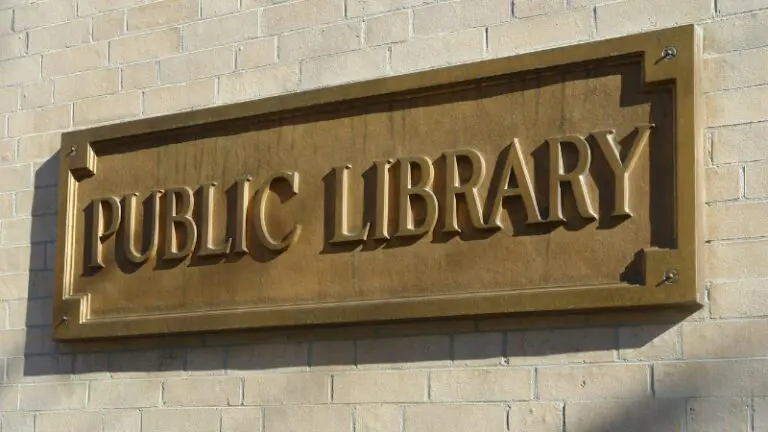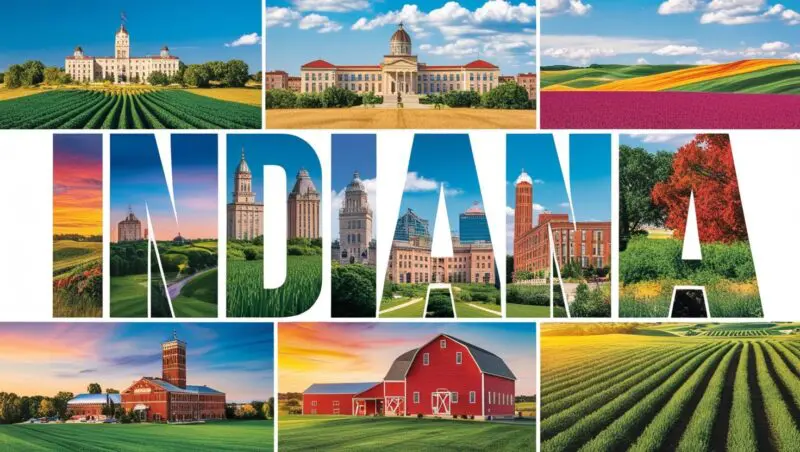If you’ve ever wondered what makes Indiana, the Hoosier State, so unique, you’re in for a treat. From its bustling cities to its serene landscapes, Indiana has a bit of everything for everyone. Let’s explore some intriguing facts about Indiana that might just make you see it in a new light.
Table of Contents
Toggle1. Indiana is the 17th most populous and the 38th most extensive state in the United States.
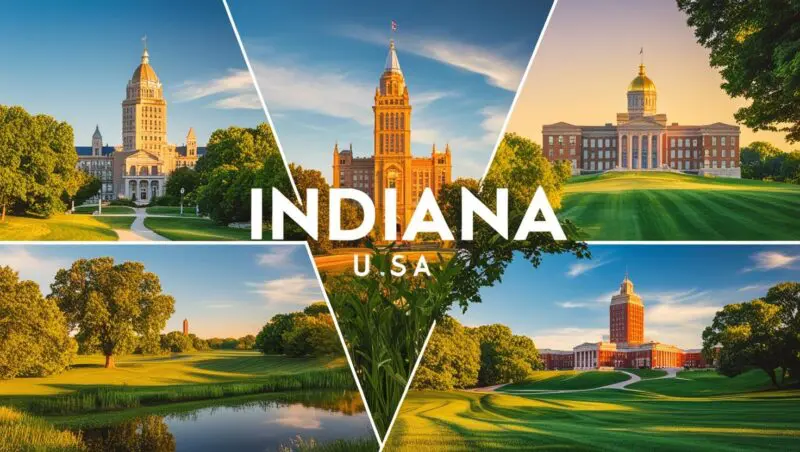
This placement underscores its moderate land area contrasted with a relatively large population, indicative of its significant urban centers such as Indianapolis, Fort Wayne, and Evansville, which contribute to its density.
The state’s demographic mix includes a substantial rural population alongside its urban centers. The population density varies significantly, with densely populated areas concentrated around major cities and more sparsely populated rural areas.
2. It joined the union on December 11, 1816, as the 19th state.
Indiana became the 19th state to join the Union on December 11, 1816. This marked a significant expansion westward during the early years of the United States, reflecting the country’s growth and development beyond the original thirteen colonies. This addition represented a critical step in the westward movement of the American frontier.
3. Indiana borders Illinois, Kentucky, Michigan, and Ohio.
Indiana is bordered by Illinois to the west, Kentucky to the south, Michigan to the north, and Ohio to the east. This location in the heart of the Midwest makes it a key crossroads for commerce and travel in the region. Its geographical position has historically made it a pivotal area for transportation and logistics in the United States.
The state serves as a crucial link between the eastern states and the growing western frontiers.
4. The state has 92 counties and its capital is Indianapolis.
5. Michael Jackson was born in Gary, Indiana on August 29, 1958.
Michael Jackson, famously known as the “King of Pop,” was born in Gary, Indiana, on August 29, 1958. Gary’s recognition is partly due to this connection with Jackson, one of the most celebrated figures in the music industry.
6. Ray Ewry from Lafayette, Indiana won 8 Olympic gold medals in track and field.
Ray Ewry from Lafayette, Indiana was a track and field athlete who won 8 Olympic gold medals.
He overcame polio as a young boy and became one of the most successful Olympians of all times.#tuesdayvibepic.twitter.com/7A0LwyXuiF
— Chris (@ChrisandOla) October 18, 2023
Ray Ewry, born in Lafayette, Indiana, won a total of 8 Olympic gold medals in early 20th-century games. Remarkably, he achieved this feat despite earlier battles with polio that initially left him using a wheelchair, illustrating a story of remarkable perseverance and strength.
7. Child prodigy Jacob Barnett from Indiana enrolled in college at age 12.
Jacob Barnett from Indiana, diagnosed with Asperger Syndrome and Autism at age two, showed extraordinary intellectual capabilities by enrolling in college at just 12 years old. His story highlights the potential within every individual, regardless of the challenges they face.
8. Bedford, Indiana is known as the “Limestone Capital of the World.”
Bedford, Indiana, earned the nickname “Limestone Capital of the World” because of its abundant local quarries. The high-quality limestone from this area has been used in numerous notable national constructions, including prominent federal buildings.
The limestone industry has been a significant part of Bedford’s economy for over a century, providing material for architectural projects nationwide. Bedford’s limestone is renowned for its consistent texture and high purity, making it a preferred material for architects.
9. Limestone from Indiana was used in the construction of the Empire State Building, the Pentagon, and other significant buildings.
Indiana limestone was used in the construction of major landmarks such as the Empire State Building, the Pentagon, and Washington, D.C.’s National Cathedral. This fact underlines the importance of Indiana’s natural resources in American architectural history.
Many of Indiana’s limestone quarries are still operational, continuing to supply stone for new constructions and restorations.
10. The Indy 500, a major automobile race, is held annually in Speedway, Indiana.
frick it, here’s the full 2024 Indianapolis 500 🥛🏎️ pic.twitter.com/dPRdrBrNsg
— NTT INDYCAR SERIES (@IndyCar) December 28, 2024
The Indianapolis 500, held annually at the Indianapolis Motor Speedway in Speedway, Indiana, is one of the most prestigious events in the world of motorsports, drawing over 250,000 attendees each May. It is famous for the tradition of the race winner drinking a bottle of milk, a practice that started in 1936.
11. The world’s largest anatomically correct sculpture of the human brain is located at Indiana University.
The world’s largest anatomically-correct brain sculpture resides just outside the @IUPsych building, standing seven feet tall and weighing over 10,000 pounds. The sculpture was unveiled in 2013 to commemorate the Department of Psychological and Brain Sciences’ 125th anniversary. pic.twitter.com/dpvbNvKIjZ
— Indiana University Office of Admissions (@IUAdmissions) October 20, 2020
The Department of Psychological and Brain Sciences at Indiana University houses the world’s largest anatomically correct sculpture of a human brain, made entirely from Indiana limestone and weighing 10,000 pounds.
12. Indiana has four “moon trees” planted from seeds that orbited the moon.
Indiana is home to four “moon trees,” which were grown from seeds that orbited the moon with astronaut Stuart A. Roosa. These trees were planted in 1976 and are located in various cities throughout the state, symbolizing Indiana’s contributions to space exploration.
13. Indiana spans two time zones.
Indiana is one of the thirteen U.S. states split into more than one-time zone. This unusual arrangement reflects the state’s geographical and commercial significance, straddling the boundary between the Central and Eastern Time Zones.
The division can cause confusion, especially in border areas, but it also highlights Indiana’s pivotal role as a crossroads in national logistics and commerce.
14. The state is part of the Great Lakes Region and has around 900 lakes.
As part of the Great Lakes Region, Indiana boasts approximately 900 lakes and is situated in two major U.S. natural regions—the Central Lowlands and the Interior Low Plateaus. The largest lake is Lake Michigan, which it shares with three other states.
Indiana’s lakes are vital for recreation, tourism, and ecology, supporting diverse wildlife and offering numerous outdoor activities. The presence of Lake Michigan significantly influences the climate and economic activities in the northern part of the state, particularly in the shipping and fishing industries.
15. Wabash, Indiana was the world’s first electrically lighted city on March 31, 1880.
Wabash, Indiana, became the world’s first electrically lighted city on March 31, 1880, when its courthouse was illuminated by four powerful lamps. This pioneering event marked a significant moment in the history of electrical engineering.
16. Indiana produces more than 20% of the United States’ popcorn supply.
Indiana contributes over 20% of the popcorn supplied in the United States, making it a significant player in national agricultural production. This emphasizes the state’s agricultural diversity beyond just its well-known corn crops. The state’s favorable growing conditions and innovative farming practices have helped it become a leader in popcorn production.
17. Key industries in Indiana include manufacturing, agriculture, and education.
Manufacturing, agriculture, and education form the backbone of Indiana’s economy. The Calumet region of the state is particularly noted for its heavy industry. This industrial base is complemented by a robust educational system that includes several major universities that are leaders in research and innovation.
18. Santa Claus, Indiana, is a major tourist destination and receives over half a million “Dear Santa” letters annually.
The town of Santa Claus is renowned as “America’s Christmas Hometown.” Established in 1856, it attracts tourists, especially during the Christmas season, and engages in the heartwarming practice of responding to children’s letters to Santa.
19. Six men from Indiana have been elected as U.S. vice presidents.
Indiana has produced six vice presidents of the United States, earning it the nickname “The Mother of Vice Presidents.” This highlights its historical political influence. The state’s political heritage is a source of pride and is featured prominently in its educational curricula and public commemorations.
20. Abraham Lincoln lived in Indiana from 1816 to 1830.
Abraham Lincoln spent a significant part of his childhood in Indiana, from 1816 to 1830. His formative years in the state are commemorated at the Lincoln Boyhood National Memorial in Lincoln City.
This period in Indiana significantly influenced Lincoln’s views and moral framework, which later shaped his presidency and his enduring legacy as a leader committed to equality and justice. The memorial includes a museum and a replica farm, where visitors can learn about the life and times of Lincoln as a young boy in Indiana.
21. Martinsville had the first successful goldfish farm in the U.S. in 1899.
The first successful goldfish farm in the U.S. was established in Martinsville, Indiana, in 1899. This innovation marks an interesting niche in the state’s agricultural history. The farm began a new industry in the United States and set the precedent for domestic aquaculture.
The success of this venture led to the spread of goldfish farms across the country, making goldfish available as common household pets.
22. Indiana’s motto is “Crossroads of America” due to many transportation routes passing through the state.
The state motto “Crossroads of America” aptly describes Indiana due to its crucial role in national transportation and cross-country travel. The motto reflects the state’s strategic geographic position which has historical roots in the development of the nation’s railroad and highway systems.
23. The Ohio River forms the state’s southern border.
@indianabackroads76
The Ohio River forms Indiana’s southern border, serving as a natural division with Kentucky and a critical waterway for commerce and transportation. This river is not only an important natural resource but also a historical and recreational asset.
It has been vital for trade and transportation since the early days of American settlement and continues to be a central element in the economic activities of the region.[/su_note]
24. The Wabash River in Indiana is home to over 150 fish species.
The Wabash River, running through Indiana, supports over 150 fish species, making it a significant ecological resource within the state. This biodiversity is crucial for maintaining ecological balance and supporting local fisheries.
The river is a focal point for environmental studies and conservation efforts aimed at preserving its unique ecosystem and water quality.
25. Indiana’s largest natural lake is Lake Wawasee.
Lake Wawasee is the largest natural lake entirely within Indiana, offering recreational opportunities and contributing to the state’s natural beauty. It is a popular destination for fishing, boating, and watersports, attracting visitors from across the region.
26. The discovery of natural gas in northern Indiana in the late 1880s led to an economic boom
The late 1880s discovery of natural gas in northern Indiana spurred significant economic growth and industrial development, drawing workers and businesses to cities like Indianapolis and Gary. This boom period, often referred to as the “Gas Boom,” dramatically transformed the economic landscape of Indiana, leading to rapid urbanization and industrialization.
27. The first train robbery in the U.S. occurred in Indiana in 1866.
The first recorded train robbery in the United States occurred in Jackson County, Indiana, on October 6, 1866, marking a notorious event in American criminal history. This daring heist involved the Reno Gang, who became infamous for their train robberies.
The event highlighted the vulnerabilities of the burgeoning American railroad system and led to increased security measures on trains.
28. Indiana is the tenth largest farming state in the U.S., with 96% of farms being family-owned or operated.
Indiana is the tenth largest farming state in the U.S., with a strong emphasis on family-operated farms. The state’s agricultural output is vital to both the local and national economies. Indiana’s agricultural sector is diverse, encompassing the production of soybeans, corn, poultry, dairy, and hogs.
29. The longest-known underground river in the U.S. runs through Bluespring Caverns in Indiana.
Bluespring Caverns in Indiana features the longest-known underground river in the United States, a 21-mile-long system that supports unique aquatic life. This underground river attracts speleologists and tourists alike, offering boat tours that explore the dark, water-filled passageways.
30. The first Indiana State Fair was held in 1852.
The first Indiana state fair was held in 1852, establishing a tradition that continues to celebrate the state’s agricultural heritage and community spirit annually. The state fair has grown to include a wide range of activities, from agricultural competitions to concerts, rides, and food vendors.
In summary
Indiana offers a unique slice of American life that’s worth exploring. So, next time you’re thinking about a new adventure, why not give Indiana a try? You might just find yourself falling for the Hoosier State just like I did.
Related Posts:
- Stranger Things and Indiana - How the Hoosier State…
- Is Indiana a Republican or Democratic State? True…
- The Mastodon Could Become the State Fossil, But Is…
- Indiana’s Largest Cities by Population in 2025 - Top…
- The Ultimate Guide to the Indiana State Fair 2025
- The Hoosier Hysteria - Basketball’s Undying Legacy…




